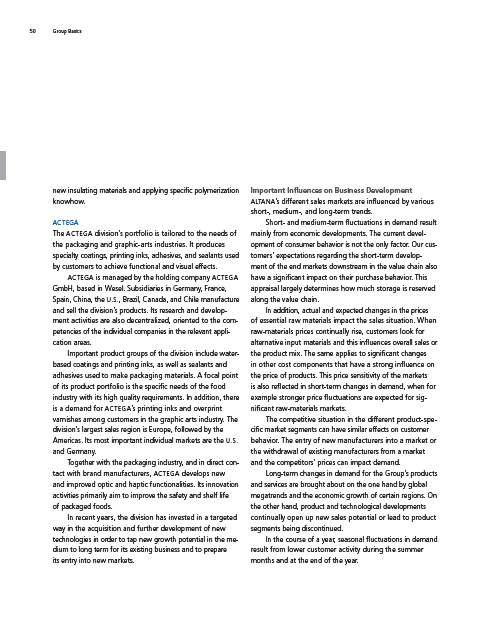
new insulating materials and applying specific polymerization
knowhow.
ACTEGA
The ACTEGA division’s portfolio is tailored to the needs of
the packaging and graphic-arts industries. It produces
specialty coatings, printing inks, adhesives, and sealants used
by customers to achieve functional and visual effects.
ACTEGA is managed by the holding company ACTEGA
GmbH, based in Wesel. Subsidiaries in Germany, France,
Spain, China, the U.S., Brazil, Canada, and Chile manufacture
and sell the division’s products. Its research and development
activities are also decentralized, oriented to the competencies
of the individual companies in the relevant application
areas.
Important product groups of the division include water-based
coatings and printing inks, as well as sealants and
adhesives used to make packaging materials. A focal point
of its product portfolio is the specific needs of the food
industry with its high quality requirements. In addition, there
is a demand for ACTEGA’s printing inks and overprint
varnishes among customers in the graphic arts industry. The
division’s largest sales region is Europe, followed by the
Americas. Its most important individual markets are the U.S.
and Germany.
Together with the packaging industry, and in direct contact
with brand manufacturers, ACTEGA develops new
and improved optic and haptic functionalities. Its innovation
activities primarily aim to improve the safety and shelf life
of packaged foods.
In recent years, the division has invested in a targeted
way in the acquisition and further development of new
technologies in order to tap new growth potential in the medium
to long term for its existing business and to prepare
its entry into new markets.
Important Influences on Business Development
ALTANA’s
different sales markets are influenced by various
short-, medium-, and long-term trends.
Short- and medium-term fluctuations in demand result
mainly from economic developments. The current development
of consumer behavior is not the only factor. Our customers’
expectations regarding the short-term develop-
ment of the end markets downstream in the value chain also
have a significant impact on their purchase behavior. This
appraisal largely determines how much storage is reserved
along the value chain.
In addition, actual and expected changes in the prices
of essential raw materials impact the sales situation. When
raw-materials prices continually rise, customers look for
alternative input materials and this influences overall sales or
the product mix. The same applies to significant changes
in other cost components that have a strong influence on
the price of products. This price sensitivity of the markets
is also reflected in short-term changes in demand, when for
example stronger price fluctuations are expected for significant
raw-materials markets.
The competitive situation in the different product-specific
market segments can have similar effects on customer
behavior. The entry of new manufacturers into a market or
the withdrawal of existing manufacturers from a market
and the competitors’ prices can impact demand.
Long-term changes in demand for the Group’s products
and services are brought about on the one hand by global
megatrends and the economic growth of certain regions. On
the other hand, product and technological developments
continually open up new sales potential or lead to product
segments being discontinued.
In the course of a year, seasonal fluctuations in demand
result from lower customer activity during the summer
months and at the end of the year.
50 Group Basics